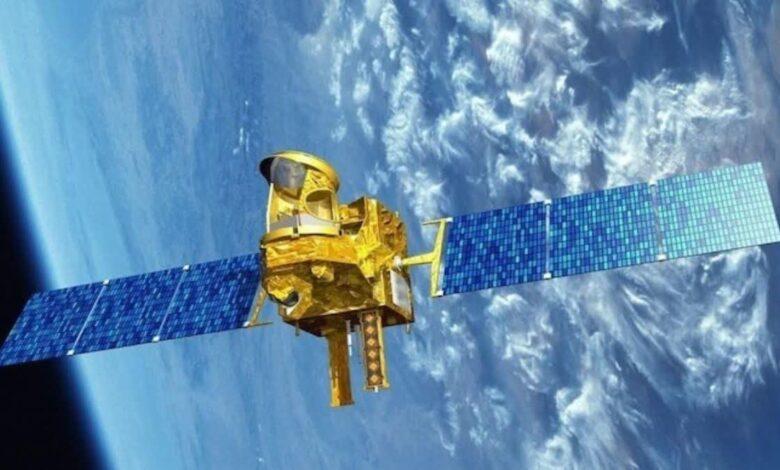
The Indian Space Research Organisation (ISRO) is on the cusp of another significant launch, poised to deploy the advanced ‘RISAT-1B’ (Radar Imaging Satellite-1B) into orbit. Equipped with cutting-edge radar imaging technology, this satellite is crucial for bolstering national security, managing natural resources, and aiding disaster relief efforts.
Experts note the timing of this mission, coming shortly after the successful ‘Operation Sindoor’, underscores its importance.
RISAT-1B is expected to provide the armed forces with a vital capability for monitoring India’s sensitive borders with Pakistan and China, as well as safeguarding its extensive coastline. As a successor to the already successful RISAT series, this satellite, with its enhanced capabilities, marks another milestone in India’s space technology journey. The launch, scheduled for May 18, 2025, at 6:59 am Indian Standard Time from the Satish Dhawan Space Centre in Sriharikota, has already garnered national attention. ISRO will use its reliable Polar Satellite Launch Vehicle PSLV-C61 to place the approximately 1,710-kilogram satellite into a sun-synchronous polar orbit at an altitude of around 529 kilometers. From this vantage point, RISAT-1B will be able to image every part of the Earth at regular intervals.
RISAT-1B’s Advanced Technological Arsenal:
The success of RISAT-1B hinges on the sophisticated technology it carries, with the Synthetic Aperture Radar (SAR) at its core. This analysis delves into the significance, benefits, and technical aspects of RISAT-1B.
A New Chapter in India’s Space Odyssey:
With a proven track record of indigenous achievements in the space sector, ISRO continues to design and launch state-of-the-art satellites tailored to the nation’s needs, standing proudly alongside global spacefaring nations. ISRO’s services in communication, Earth observation, meteorology, and navigation are invaluable. In this context, ‘RISAT-1B’, also known as an Earth Observation Satellite (EOS), has been developed with a focus on critical areas such as national security, resource monitoring, and swift disaster response. It is built with radar imaging technology capable of delivering clear images even under adverse weather conditions. The successful deployment of this satellite promises to significantly enhance India’s surveillance capabilities, providing a strategic advantage to the nation.
The RISAT Lineage – A Landmark in Indian Space Technology:
The RISAT (Radar Imaging Satellite) series represents a revolutionary step forward in India’s Earth observation program. Conventional remote sensing satellites with optical cameras are limited by cloud cover and darkness. To overcome this, ISRO focused on radar technology. Radar waves can penetrate clouds and operate day and night, providing continuous imagery of the Earth’s surface. The first satellite in this series, ‘RISAT-2’, was launched on April 20, 2009. Notably, it was developed in collaboration with Israel Aerospace Industries and featured an X-band Synthetic Aperture Radar (SAR). Its launch was expedited following the 2008 Mumbai terror attacks to address the urgent need for border surveillance and monitoring of terrorist activities, and it proved to be highly effective.
Subsequently, ISRO indigenously developed ‘RISAT-1’ with a C-band Synthetic Aperture Radar, successfully launching it on April 26, 2012. This satellite was primarily intended for civilian applications such as agriculture, forestry monitoring, and disaster management. Serving for approximately five years, RISAT-1 provided crucial data, including Kharif crop assessments and identification of flood-affected areas. Continuing this lineage, ISRO launched more advanced satellites like RISAT-2B (May 2019) and RISAT-2BR1 (December 2019). While prioritizing national security and surveillance, these satellites also served civilian purposes, providing imagery and data that greatly assisted defense forces and disaster management agencies. ‘RISAT-1B’ now stands as the next significant step in this successful series.
RISAT-1B: Ushering in a New Era – Necessity and Special Features:
With several RISAT series satellites already providing valuable services, the necessity of ‘RISAT-1B’ might arise. Several factors underscore its importance. Technology is constantly evolving, and replacing older satellites with more advanced, higher-capacity ones enhances the quality and scope of services. RISAT-1B fits this rationale, incorporating state-of-the-art technology. While a successor to RISAT-1, RISAT-1B features a more advanced C-band Synthetic Aperture Radar, enabling clearer, higher-resolution imagery. It is reported to have five distinct imaging modes, capable of providing everything from ultra-high-resolution images for identifying minute objects to broader scan imagery for wide-area surveillance. In the current geopolitical scenario, continuous surveillance along national borders is paramount.
Satellites like RISAT-1B are crucial for constantly monitoring sensitive border regions with countries like China and Pakistan, detecting infiltrations, and identifying terrorist activities. It adds significant strength to the services already provided by previous satellites. Every satellite in orbit has a limited operational lifespan. Launching new satellites before the older ones expire ensures uninterrupted data collection. Furthermore, having more satellites in orbit increases the revisit capability over a particular area, allowing for quicker detection of changes. This mission also aligns with the goal of self-reliance. Such indigenous satellites play a vital role in reducing dependence on foreign satellites for critical defense and strategic information, and RISAT-1B is a testament to ISRO’s efforts in this direction.
The Synthetic Aperture Radar on board is significantly more powerful than conventional radars. It can generate high-resolution images equivalent to those produced by a much larger antenna. As the satellite moves, it emits a series of radar pulses towards the Earth and receives the echoes. This data is then processed using sophisticated algorithms in computers to create two-dimensional (2D) or three-dimensional (3D) images of the Earth’s surface. It’s called a ‘synthetic’ antenna because the satellite’s movement is used to simulate a larger antenna. RISAT-1B utilizes a C-band (approximately 5.35 GHz frequency) radar. This frequency has the ability to penetrate atmospheric obstructions like clouds, rain, and fog, providing clear imagery.
This makes it particularly suitable for applications such as agriculture and soil moisture assessment. Unlike optical cameras that rely on sunlight, radar satellites ‘see’ the Earth using their own energy source (radar pulses). Therefore, they can acquire images 24/7, regardless of day or night. RISAT-1B features various imaging modes, including ‘Spotlight’ mode for detailed viewing of small areas requiring high resolution, ‘Stripmap’ mode for covering larger areas with moderate resolution, and ‘ScanSAR’ mode for rapidly scanning very wide areas with lower resolution. This versatility allows a single satellite to be used for multiple purposes. For instance, the modes can be switched to identify a small bunker on the border or to assess the extent of flooding in a large state. To transmit the vast amounts of data collected by the satellite to Earth quickly and securely, it is equipped with a powerful data handling system and transmission equipment. All these technological capabilities combine to make RISAT-1B a formidable Earth observation satellite.
Multifaceted Benefits – A Shield for the Nation:
The services provided by RISAT-1B extend beyond a single sector, contributing to the progress and security of the nation in numerous ways.
Strategic Strength in Defence:
Continuous surveillance is crucial for India, which shares long and sensitive borders with Pakistan and China. RISAT-1B can detect enemy troop movements, infiltrations and illegal constructions along the borders. It can also help in identifying terrorist training camps and their movements, providing vital intelligence to security forces. News reports suggest that older RISAT satellites played a key role in operations like the Balakot strikes, and RISAT-1B is expected to enhance this capability further. It will be instrumental in monitoring suspicious vessels and ships in the vast coastline, helping to curb illegal trafficking and piracy.
A Lifeline During Disasters: During floods, RISAT-1B imagery can quickly identify inundated areas facilitate rescue operations, and assess damage. Its ability to image through dense clouds makes its role critical during such events. It can also assist in assessing the damage caused by cyclones during and after they make landfall. In the aftermath of natural disasters like earthquakes and landslides, it can provide images of affected areas, enabling relief teams to plan their operations effectively.
Supporting Agricultural Development:
RISAT-1B data can be used to estimate the area under cultivation for different crops, assess crop health, and predict yields. This helps governments in formulating food security plans. By estimating soil moisture levels, it contributes to irrigation management and drought assessment. Radar data can also be used to detect certain crop diseases and their spread. It aids in monitoring forest cover, deforestation, and forest fires, contributing to biodiversity conservation. It can be used to create land-use maps (agriculture, forests, settlements, industrial areas, etc.) and to plan urban expansion. Its data is also valuable for monitoring water levels in rivers, lakes, and reservoirs, as well as for groundwater exploration. It can help in identifying icebergs and oil spills in the sea, ensuring the safety of shipping routes.
Operational Lifespan and Future Plans:
ISRO anticipates that RISAT-1B will provide services for approximately 10 years after its deployment in orbit. During this period, it will continuously provide crucial information about the Earth. ISRO has plans to launch more advanced Earth observation satellites in the future. The ‘NISAR’ satellite, being jointly developed by NASA and ISRO, will also operate with radar technology, using dual frequencies (L-band and S-band) for a more comprehensive study of the Earth. Satellites like RISAT-1B lay a strong foundation for these future endeavors.
Another Step Towards Self-Reliance:
The launch of RISAT-1B is not just about sending another satellite into space. It is a significant step in India’s scientific and technological progress and its pursuit of self-reliance. The role of this satellite in enhancing the nation’s capabilities in critical sectors such as defense, agriculture, environmental protection, and disaster management is invaluable. We can only hope that the efforts of ISRO scientists, who continue to overcome challenges and advance with new innovations, will once again bear fruit, and RISAT-1B will successfully serve the nation. It undoubtedly exemplifies the spirit of “Make in India” and India’s growing stature in technological dominance.











